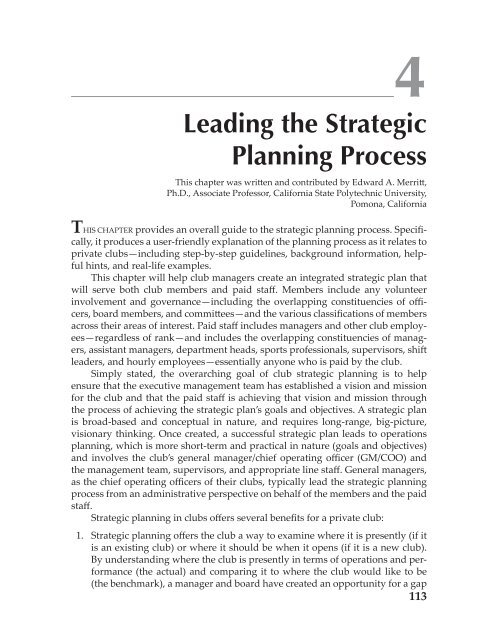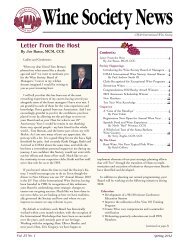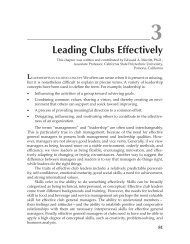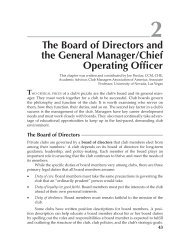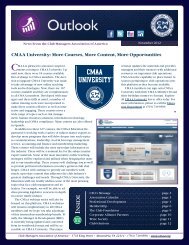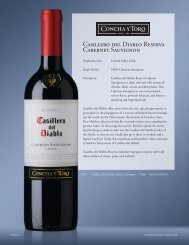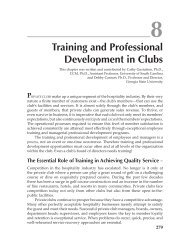Leading the Strategic Planning Process - Club Managers ...
Leading the Strategic Planning Process - Club Managers ...
Leading the Strategic Planning Process - Club Managers ...
- No tags were found...
Create successful ePaper yourself
Turn your PDF publications into a flip-book with our unique Google optimized e-Paper software.
4<strong>Leading</strong> <strong>the</strong> <strong>Strategic</strong><strong>Planning</strong> <strong>Process</strong>This chapter was written and contributed by Edward A. Merritt,Ph.D., Associate Professor, California State Polytechnic University,Pomona, CaliforniaTHIS CHAPTER provides an overall guide to <strong>the</strong> strategic planning process. Specifically,it produces a user-friendly explanation of <strong>the</strong> planning process as it relates toprivate clubs—including step-by-step guidelines, background information, helpfulhints, and real-life examples.This chapter will help club managers create an integrated strategic plan thatwill serve both club members and paid staff. Members include any volunteerinvolvement and governance—including <strong>the</strong> overlapping constituencies of officers,board members, and committees—and <strong>the</strong> various classifications of membersacross <strong>the</strong>ir areas of interest. Paid staff includes managers and o<strong>the</strong>r club employees—regardlessof rank—and includes <strong>the</strong> overlapping constituencies of managers,assistant managers, department heads, sports professionals, supervisors, shiftleaders, and hourly employees—essentially anyone who is paid by <strong>the</strong> club.Simply stated, <strong>the</strong> overarching goal of club strategic planning is to helpensure that <strong>the</strong> executive management team has established a vision and missionfor <strong>the</strong> club and that <strong>the</strong> paid staff is achieving that vision and mission through<strong>the</strong> process of achieving <strong>the</strong> strategic plan’s goals and objectives. A strategic planis broad-based and conceptual in nature, and requires long-range, big-picture,visionary thinking. Once created, a successful strategic plan leads to operationsplanning, which is more short-term and practical in nature (goals and objectives)and involves <strong>the</strong> club’s general manager/chief operating officer (GM/COO) and<strong>the</strong> management team, supervisors, and appropriate line staff. General managers,as <strong>the</strong> chief operating officers of <strong>the</strong>ir clubs, typically lead <strong>the</strong> strategic planningprocess from an administrative perspective on behalf of <strong>the</strong> members and <strong>the</strong> paidstaff.<strong>Strategic</strong> planning in clubs offers several benefits for a private club:1. <strong>Strategic</strong> planning offers <strong>the</strong> club a way to examine where it is presently (if itis an existing club) or where it should be when it opens (if it is a new club).By understanding where <strong>the</strong> club is presently in terms of operations and performance(<strong>the</strong> actual) and comparing it to where <strong>the</strong> club would like to be(<strong>the</strong> benchmark), a manager and board have created an opportunity for a gap113
Exhibit 1 The <strong>Club</strong> <strong>Strategic</strong> <strong>Planning</strong> Pyramid<strong>Leading</strong> <strong>the</strong> <strong>Strategic</strong> <strong>Planning</strong> <strong>Process</strong> 115<strong>Club</strong> <strong>Strategic</strong> <strong>Planning</strong>Responsibility of board of governorsand GM/COOFunctional <strong>Strategic</strong> <strong>Planning</strong>Responsibility of functionaldepartment heads (i.e., marketing,finance, IT, HR)Operations <strong>Strategic</strong> <strong>Planning</strong>Responsibility of operationsdepartment heads (i.e., F&B,sports professionals)as marketing, finance, information technology, and human resources—usuallytake <strong>the</strong> lead in creating functional strategic plans (in conjunction with<strong>the</strong> GM/COO). The primary planning issues include creating departmentalstrategies and initiatives to support <strong>the</strong> club’s overall strategic plan and to createand achieve departmental performance goals and objectives.• Operations strategic planning: The operations department heads—typicallyrepresented by <strong>the</strong> food and beverage director and <strong>the</strong> heads of <strong>the</strong> varioussports areas at <strong>the</strong> club (golf, tennis, swim, fitness, equestrian, etc.)—usuallytake <strong>the</strong> lead in operational strategic planning (again, in conjunctionwith <strong>the</strong> GM/COO). Primary planning issues include creating departmentspecificstrategies aimed at supporting <strong>the</strong> club’s strategic plan and creatingand achieving departmental performance goals and objectives.This chapter has been written under <strong>the</strong> assumption that no formal strategicinitiative exists at a particular club. Thus, <strong>the</strong> chapter is organized chronologically:GM/COOs and students can follow along, step-by-step, to see how anorganized and integrated strategic plan for clubs is put toge<strong>the</strong>r. Realistically,however, <strong>the</strong> overwhelming majority of clubs will have at least some elements ofa strategic plan in place. In <strong>the</strong>se cases, GM/COOs can look at <strong>the</strong> chapter moregenerally, to see <strong>the</strong> relationships among and general order of <strong>the</strong> strategic planningelements. While <strong>the</strong> individual elements work best in <strong>the</strong> order and mannerspecified, <strong>the</strong>y can also serve supplemental functions alongside a given club’scurrent practices. In short, this chapter works as well for existing clubs seeking
116 Chapter 4to improve or adapt a strategic plan as it does for new clubs attempting to createan entirely new plan.Organizational <strong>Strategic</strong> <strong>Planning</strong>:A Step-by-Step <strong>Process</strong><strong>Strategic</strong> planning helps you lead your club from a long-term perspective. For aclub, strategic planning always relates to <strong>the</strong> club’s self-definition of what it wantsto become. Thus, strategic planning affects operational decisions and determineshow <strong>the</strong> club will practically achieve what it ideally wants to be.Undertaking <strong>the</strong> process of strategic planning can be a daunting task. Thereare a number of elements inherent in <strong>the</strong> creation of an integrated strategic planthat may, at first glance, confuse even <strong>the</strong> most experienced club manager. However,when considered in a progressive order of importance, <strong>the</strong>se elements workclearly and crucially with each o<strong>the</strong>r. They are:1. Vision2. Mission3. Goals4. Objectives5. Organizational situation analysis (SWOT)6. Strategy statement7. Budgets8. Action plan9. Assessing progressIf any step is not already in place at <strong>the</strong> club, <strong>the</strong> manager responsible for <strong>the</strong>strategic planning process should ensure that <strong>the</strong> missing step is completed beforeproceeding to <strong>the</strong> next stage of <strong>the</strong> process.From <strong>the</strong> outset of <strong>the</strong> planning process, be sure to create an atmospherein which contributions are welcomed. Essentially, you want to help ensure thatall participants can safely share ideas, without <strong>the</strong> ideas being shouted down orignored as being insignificant or o<strong>the</strong>rwise unimportant.To help you set <strong>the</strong> appropriate tone:1. Encourage active involvement. All participants (in any meeting or planningsession) should be actively involved in <strong>the</strong> process. Stating participationexpectations up front can help keep impatient or more vocal participantsfrom controlling <strong>the</strong> process and potentially shutting down creative viewpointsand ideas.2. Solicit different points of view. The idea during <strong>the</strong>se strategic planning sessions—especiallyin <strong>the</strong> early stages—is to get broadness of ideas. You mayfind it helpful to announce that <strong>the</strong> purpose is to generate a lot of ideas
118 Chapter 4clubs regularly. A group that is unified, vocal, and passionate—no matter howsmall—can be very influential.4. Unanimity. The perceived strength of a unanimous decision lies in <strong>the</strong> factthat all eligible voters voted on a decision—whe<strong>the</strong>r for or against—with noabstentions. Unanimity is a form of decision by majority, unique because <strong>the</strong>“100-percent” vote often fur<strong>the</strong>r legitimizes <strong>the</strong> decision.5. Consensus. Decision by consensus is, by far, <strong>the</strong> “bread-and-butter” decision-makingmodel most used in <strong>the</strong> private club environment. Consensus,like majority, is technically decision by authority; in consensus, though, <strong>the</strong>authoritarian allows participants to arrive at a decision informally and usuallywithout a vote. The leader compromises throughout <strong>the</strong> discussion tohelp ensure inclusion before asking for consensus among members—typicallyindicated by a simple nod of agreement or non-response. The decision is<strong>the</strong>n adopted.Once your strategic planning meetings are appropriately focused—that is, amediator has been identified, participants are enthusiastic about <strong>the</strong> process, andeveryone understands how decisions will be made at <strong>the</strong> meetings—<strong>the</strong> strategicplanning process can begin by outlining your club’s vision.VisionVision is perhaps <strong>the</strong> most fundamental of <strong>the</strong> strategic planning elements.Vision is future-oriented and identifies what <strong>the</strong> club is all about—its purposefor being—as well as where <strong>the</strong> club is heading. Infusing <strong>the</strong> club with a definitesense of purpose, a club’s vision states a direction for <strong>the</strong> club and describes <strong>the</strong>destination.At <strong>the</strong> outset of “visioneering,” which usually begins at <strong>the</strong> board level, itis important to assess o<strong>the</strong>rs’ concept of vision. However, it is often difficult forboard members to find a common language to describe <strong>the</strong>ir respective visions of<strong>the</strong> club. One effective way to bring about an understanding of vision is to make acomparison between <strong>the</strong> club and an idea or object unrelated to <strong>the</strong> club. In makingsuch a comparison—constructing a metaphor to describe <strong>the</strong> club—it is helpfulto select a product—automobiles, for example—with widespread familiarityand a high degree of stratification.It may sound silly at first, but getting fundamental agreement on what a clubis presently and what <strong>the</strong> club should be creates <strong>the</strong> opportunity for a “gap analysis”—forwhich an automobile-related metaphor is an effective tool. For example,as you begin <strong>the</strong> strategic planning process with your board, you might ask thisquestion during <strong>the</strong> meeting: “If this club were a car, what kind of car should itbe?” This question works equally well for existing clubs (those that have somestrategic planning elements in place) or new clubs that are seeking to define <strong>the</strong>mselves.The question is straightforward, understandable, and—perhaps mostimportantly—prompts <strong>the</strong> “visioneering” process.
<strong>Leading</strong> <strong>the</strong> <strong>Strategic</strong> <strong>Planning</strong> <strong>Process</strong> 119This discussion often will go on for some time, as participants share <strong>the</strong>irdefinition or view of <strong>the</strong> club in ideal terms. Be careful not to rush this discussion. Itis <strong>the</strong> most foundational discussion in <strong>the</strong> entire process, because it sets <strong>the</strong> club’sdirection. And expect to get a variety of answers—though <strong>the</strong>re may be less variationamong answers if <strong>the</strong> meeting is attended by board members alone. Typically,“Mercedes-Benz,” “BMW,” and “Jaguar” top <strong>the</strong> list of responses.A logical follow-up question establishes <strong>the</strong> current state of <strong>the</strong> club and highlights<strong>the</strong> disparity of members’ views and responses: “Continuing with our caranalogy, what kind of car is <strong>the</strong> club presently?” This question is similar to <strong>the</strong> first,but forces <strong>the</strong> participants to assess <strong>the</strong> club’s actual and current status—what <strong>the</strong>club is—ra<strong>the</strong>r than an intended ideal. Again, plan for an extended discussion asparticipants voice <strong>the</strong>ir opinions about how <strong>the</strong> club meets expectations and whereit may fall short—all in <strong>the</strong> context of <strong>the</strong> club as an automobile. And, as before,expect to get a variety of answers. In addition to <strong>the</strong> answers listed above, answerssuch as “Volkswagen,” “Bentley,” “Chevrolet,” “Ferrari,” and even “Edsel” are notuncommon.While it may seem that you have opened <strong>the</strong> proverbial “can of worms” withthis question, <strong>the</strong> answers are important clues to what <strong>the</strong> club’s members trulythink about <strong>the</strong> club in its present condition. Celebrate <strong>the</strong> fact that you now haveactual data to work with! To turn this data into useful, practical information, youmust compare <strong>the</strong> ideal and actual descriptions of <strong>the</strong> club. This is an effective “gapanalysis” of where you are presently as a club and where you want to be ideally asa club.After comparing answers and identifying <strong>the</strong> gap, you and your plannersshould analyze <strong>the</strong> answers in terms of <strong>the</strong> participants’ demographics and membershipcharacteristics (as much as club tradition and member preferences allow).For example, if most of your tennis-member respondents described <strong>the</strong> currentstate of <strong>the</strong> club in terms of economy or low-end cars, <strong>the</strong>n you might considerexamining <strong>the</strong> tennis department and operation—its facilities, staff, and programs—tosee why it is falling short in <strong>the</strong> opinion of <strong>the</strong>se members.Sometimes it is necessary to probe for more details, in order to elicit richerinformation for use in decision-making. Asking <strong>the</strong> question “What kind of car is<strong>the</strong> club presently?” to assess members’ actual perception of <strong>the</strong> club is good as faras it goes, but if <strong>the</strong> discussion stalls, you can also ask more specific and probingquestions, such as:• What model is <strong>the</strong> car?• What is its condition?• What is <strong>the</strong> quality of its stereo? its tires?• What options does this car have?Depending on <strong>the</strong> willingness and enthusiasm of your group, you may needto keep probing to get people engaged and talking. (Once you get <strong>the</strong>m talking,don't forget to make sure that all of <strong>the</strong>ir responses are recorded—this will getmore difficult as <strong>the</strong> pace of <strong>the</strong> discussion picks up.) For example, if members
120 Chapter 4answer initial questions vaguely, probe for meaning: Mr. Gordon, you stated that<strong>the</strong> present club would be a Mercedes-Benz S-Class, with a faded paint job and brokendashboard controls. Will you please elaborate a bit, so I can get a clearer idea of what youare saying? Do <strong>the</strong> controls work occasionally? Are <strong>the</strong>y missing entirely? Why is <strong>the</strong>paint faded? How does this automobile resemble <strong>the</strong> club? Naturally, <strong>the</strong>se additionalprompts will lead into more specific discussion about <strong>the</strong> club itself, as <strong>the</strong> frameworkof <strong>the</strong> car metaphor generates discussion about values and qualities thatapply to <strong>the</strong> club.Here is an example of <strong>the</strong> vision statement for a start-up club that used <strong>the</strong>automobile-as-metaphor process:The Country <strong>Club</strong> of Tarantula Canyon will create an exciting, innovative, differentiated,private club experience that will redefine quality in Sou<strong>the</strong>rn California.By creating a country club experience that is second to none, continuouslyinnovating while recognizing tradition and broadening our appeal to <strong>the</strong>members and prospective members, we will be successful in our quest for excellence.Our success in <strong>the</strong>se endeavors will create greater value for our membersand greater desirability for prospective members.This is an example of a successful club that envisions itself as a Rolls-Royce–level club. By aligning its infrastructure, service, and facilities toward <strong>the</strong> “highend,”<strong>the</strong> club has initiation fees at <strong>the</strong> upper end, expensive (and inclusive) dues,and impeccable service. Members expect to pay a lot; however, <strong>the</strong>y expect exceptionalvalue as well.Think for a moment about this successful club. It knows what it is and whoits members are. The message—We are a Rolls-Royce–level club—is clearly communicatedin everything that <strong>the</strong> club staff and management think, say, and do. Theclub does not appeal to Chevrolet-level members and does not try to do so. Instead,it focuses its marketing toward skimming <strong>the</strong> “cream” from <strong>the</strong> highest incomeearners in Sou<strong>the</strong>rn California—those who routinely shop on Rodeo Drive.But do not misunderstand this concept. There is nothing wrong with a beinga Chevrolet-type club, and <strong>the</strong>re are a number of extremely successful Chevroletlevelclubs. But those clubs are successful because <strong>the</strong>y understand clearly that<strong>the</strong>y are Chevrolet-level clubs—that is what <strong>the</strong>y are, that is how <strong>the</strong>y market<strong>the</strong>mselves, and that is how <strong>the</strong>y want to be defined. These clubs typically haveaverage initiation fees and dues structures and have a full array of reasonablymaintained (but not lavishly maintained) facilities. They are dependable, but notflashy or extravagant. Their strength lies in <strong>the</strong>ir ability to know clearly what <strong>the</strong>yare as clubs.Problems often develop when some among a given club’s population—whe<strong>the</strong>r club managers, staff members, club members, or o<strong>the</strong>rs—do not sharethis clear understanding of <strong>the</strong>ir club’s vision. Think for a moment about <strong>the</strong>member who visits ano<strong>the</strong>r club and notices a number of <strong>the</strong> special offeringsand amenities that <strong>the</strong> host club offers, only to return to his or her home cluband suggest that you, <strong>the</strong> GM/COO, immediately adopt similar offerings. Therequests may be simple and easily achieved. But it may <strong>the</strong>n lead to larger andmore elaborate requests. Where does it stop? This sort of “Pandora’s box” effect
122 Chapter 4and do for <strong>the</strong> next 25 years—to become a powerhouse swimming club with oneof <strong>the</strong> top Amateur Athletic Union (AAU) programs in <strong>the</strong> nation. In hindsight, it isclear that a specific vision nurtured a strong commitment. With that strong commitment,potential members flocked to <strong>the</strong> club so <strong>the</strong>ir kids could be a part of thisnew, unprecedented swimming program. Over <strong>the</strong> years, <strong>the</strong> club produced scoresof world-class swimmers, including several Olympic medalists. At <strong>the</strong> club’s peak,<strong>the</strong>re was a three-year waiting list of people wanting to join.Realize that Consultants Are Not MagiciansNobody understands your club better than your managers, staff, and membersunderstand it. Given this reality, why do scores of clubs each year pay thousandsof dollars for consultants to come in and tell <strong>the</strong>m what to do in terms of strategicplanning? While consultants can be very helpful, <strong>the</strong>y are not magicians. Consultantscan lay out <strong>the</strong> elements of <strong>the</strong> strategic planning process, and <strong>the</strong>y have <strong>the</strong>additional experience of having seen and analyzed a wide variety of solutions tofairly common club issues. Their external expertise, however, cannot substitute for<strong>the</strong> club’s internal knowledge of its own personality. In <strong>the</strong> end, what works for anyparticular club is based on that particular club’s personality or culture.may be over-generalizing <strong>the</strong> situation. Still, without a clear understanding ofwhat a club is about—its vision—club members often tend to push for <strong>the</strong>irChevrolet clubs to slowly morph into Cadillac clubs. A clear understanding ofwhat kind of club yours is helps prevent this from occurring—or at least fromoccurring without careful examination.For example, one club located in North Carolina gave <strong>the</strong> impression of beinga Chevrolet-level club. Modest by most standards, <strong>the</strong> club had, however, a fewareas of discontinuity in operations. These inconsistencies helped explain <strong>the</strong>club’s dire financial straits. All cars were parked by valets, which added to laborcosts. The house scotch was Chivas Regal, an expensive scotch priced at a mere $2for a two-ounce pour (including tax and gratuity)—a cost dictated by a past clubpresident who preferred <strong>the</strong> expensive brand to <strong>the</strong> former house scotch. Tableclothswere of an average quality, a standard polyester blend, but <strong>the</strong> china wasVilleroy & Boch (very high quality) and <strong>the</strong> flatware was Reed & Barton (very highquality). Luncheon steaks were Angus beef and <strong>the</strong> sandwich bread was custombakedat a local bakery. An interview with <strong>the</strong> general manager revealed that hehad been “helpfully advised” by some of <strong>the</strong> club members over <strong>the</strong> years; that is,he had been pressured by governors, influential committee chairs, and powerfulmembers to make <strong>the</strong>se and o<strong>the</strong>r changes based on <strong>the</strong>ir personal whims.Frankly, this club would have been more accurately described as a Frankensteinclub instead of a Chevrolet club. Certain elements of <strong>the</strong> club were so outof line with its basic identity that <strong>the</strong> club had morphed into a monster—a bit ofthis, a bit of that. But, after beginning <strong>the</strong> strategic planning process, includingidentifying a clear vision, <strong>the</strong> club has re-created itself. A visionary president andGM/COO took charge of <strong>the</strong> arduous re-creation process in order to make <strong>the</strong> club
124 Chapter 4members have access to great tennis services and facilities, but little else—but<strong>the</strong>y offer a great value to tennis enthusiasts.• Focused differentiation: Focused differentiation emphasizes uniqueness andprice, but for a narrow market. For example, some high-end, independent,member-owned clubs offer a single membership plan at a high price, marketing<strong>the</strong>mselves as “elite”—and <strong>the</strong>reby appealing to a narrow, affluent audience.Their intangible array of desirable relationships and excellent facilitieshelps <strong>the</strong>m capture a low number of total sales, but at high price. Rolls-Royceand Ferrari market in this manner.While <strong>the</strong> focused differentiation strategy is often stereotypically assumed tobe <strong>the</strong> business model of all private clubs, any of <strong>the</strong>se generic strategies can workquite well. Remember, though, that <strong>the</strong> desirability of each strategy depends on<strong>the</strong> goals of each particular club.During <strong>the</strong> vision stage of strategic planning, it is essential to clarify <strong>the</strong> club’sgeneric strategy. Are we going to be a low-cost club (relatively speaking, in relationto o<strong>the</strong>r clubs), a differentiation club, a focused low-cost club, or a focused differentiationclub? The important thing is to not allow your club to get stuck between<strong>the</strong>se positions somewhere. When a club is nei<strong>the</strong>r fish nor fowl, it gets into trouble.Often, competing forces within a club’s membership demand both high quality andlow price, which can lead a club to an untenable middle ground if it tries to satisfyboth demands. The conversation may proceed something like this:Look, I know that <strong>the</strong> regular price for a banquet is $39 per person. However, this is animportant function for a great cause. We need for you to do it for $30, including tax andgratuity, and it has to be <strong>the</strong> best event of <strong>the</strong> year because <strong>the</strong> senator will be attending.Or:Okay, here’s <strong>the</strong> plan, we really need to get a ton of new members in here. So, for <strong>the</strong> next50 members who join at <strong>the</strong> regular $100,000 initiation fee, let’s give <strong>the</strong>m free dues forten years.To begin such a fire sale on a “Rolls-Royce” club should be unthinkable,because it would betray <strong>the</strong> club’s vision, cheapen <strong>the</strong> product, and upset currentmembers. <strong>Club</strong>s that consistently stick to <strong>the</strong>ir chosen strategy in every decision<strong>the</strong>y make, whe<strong>the</strong>r it be about pricing for a banquet or ways to recruit new members,are <strong>the</strong> most successful in <strong>the</strong> long run.Connect <strong>the</strong> Vision with Operations. For a club’s vision to become reality, <strong>the</strong>reshould be a strong connection between <strong>the</strong> vision and <strong>the</strong> operation of <strong>the</strong> club.MBA students often speak of operations as “<strong>the</strong> burning platform.” Envisionan ongoing business operation as an offshore oil rig that has caught fire. The oilrig’s engineers and laborers are trained to expect a fire as part of daily operations,and are so well-trained that <strong>the</strong> operation continues even in <strong>the</strong> midst of such acatastrophe. The idea behind this illustration is simple: a club’s vision should beso well-integrated into operations that, even under stressful conditions, everyoneexecutes his or her duties in a manner consistent with that vision.
<strong>Leading</strong> <strong>the</strong> <strong>Strategic</strong> <strong>Planning</strong> <strong>Process</strong> 125To connect <strong>the</strong> vision with operations, make sure that your discussions about<strong>the</strong> club’s vision address <strong>the</strong>se issues:1. Define <strong>the</strong> club. This may seem an obvious task, but it should not be underestimated.Such discussion is essential, especially if <strong>the</strong> club has never establisheda definite purpose and reason for being. Comparing <strong>the</strong> club to cars, assuggested previously, is one way to help you define <strong>the</strong> club. A private clubcan also be defined by answering three questions:• Who are <strong>the</strong> club’s members?• What are <strong>the</strong> members’ wants and needs?• How will <strong>the</strong> club satisfy <strong>the</strong> members’ wants and needs?2. Decide <strong>the</strong> long-term strategy. The long-term strategy should consider a timeframereaching five to ten years or more into <strong>the</strong> future. Generally, <strong>the</strong> moreestablished <strong>the</strong> club, <strong>the</strong> fur<strong>the</strong>r out into <strong>the</strong> future <strong>the</strong> timeframe.3. Communicate <strong>the</strong> vision. The vision should be stated clearly and in a way thatinspires staff and members alike. Communicating <strong>the</strong> vision in everythingthat a club thinks, says, or does is as important as <strong>the</strong> creation of <strong>the</strong> visionitself. Share <strong>the</strong> vision! Construct a concise, well-worded vision statement toempower employees with a higher sense of purpose. For example, a painterin <strong>the</strong> engineering department who is in tune with <strong>the</strong> club’s vision mightconsider it his job to “maintain a treasured showplace,” not simply to “paint<strong>the</strong> white trim.”MissionMission includes <strong>the</strong> broadest and highest level of club goals and objectives. Awritten mission statement includes not only <strong>the</strong> club’s vision and purpose, but also<strong>the</strong> basic services <strong>the</strong> club provides. Generally, <strong>the</strong> mission statement is one that, ifrealized, ensures <strong>the</strong> club’s success.To make <strong>the</strong> distinction between vision and mission, vision is a broaderapproach, while mission includes <strong>the</strong> vision and <strong>the</strong>n adds <strong>the</strong> basic services providedat <strong>the</strong> club.More than any o<strong>the</strong>r element of <strong>the</strong> strategic planning process, <strong>the</strong> missionstatement spells out <strong>the</strong> first-order reasons for <strong>the</strong> club’s existence. The missionstatement flows directly from <strong>the</strong> club’s vision and helps crystallize it.The mission statement should be used everywhere to communicate and reinforce<strong>the</strong> vision, and to remind <strong>the</strong> club community—members, staff, guests, vendors,and o<strong>the</strong>rs—of why <strong>the</strong> club exists and what basic services it provides.To achieve this end, <strong>the</strong> mission statement should be reproduced and printedin all club publications—in <strong>the</strong> monthly newsletter, on club stationery and letterhead,in advertisements, in public relations articles, club employee handbooks,board orientation manuals, new-member materials, and even on <strong>the</strong> membershipapplication. In short, any time you are putting toge<strong>the</strong>r a communications piece,
126 Chapter 4consider including <strong>the</strong> club’s mission statement as a companion element. Someclubs even print <strong>the</strong> mission statement on laminated business cards that paid staffmembers carry when on duty as a reminder of <strong>the</strong> club’s basic tenets.A sample mission statement for a start-up club might read as follows:The Country <strong>Club</strong> of Tarantula Canyon was created as a haven for its members.We are second to none in our purpose to offer an extraordinary array of clubexperiences, in our commitment to <strong>the</strong> highest level of member service, and inour willingness to recognize our employees as <strong>the</strong> most valuable asset within <strong>the</strong>club. Our allegiance to <strong>the</strong>se basic elements will ensure long-term success for ourmembers and staff.When creating a mission statement, carefully consider <strong>the</strong> following three elementsas a guideline:1. Common features: What are <strong>the</strong> club’s products and services? What marketsor potential members does <strong>the</strong> club pursue? What are <strong>the</strong> club’s core values?What are some of <strong>the</strong> club’s broadest goals? What is <strong>the</strong> club’s competitiveposition? What is <strong>the</strong> image that <strong>the</strong> club wants to portray to those outside <strong>the</strong>club?2. Internal scans: What are <strong>the</strong> unique strengths that <strong>the</strong> club should be knownfor and build upon? What weaknesses should <strong>the</strong> club improve upon internally?3. External scans: What demographic shifts should <strong>the</strong> club anticipate? Whatchanges in products and services may come about over <strong>the</strong> next five years?What is <strong>the</strong> club’s source of labor? What laws and regulations could change<strong>the</strong> ways that <strong>the</strong> club does business? What are <strong>the</strong> strengths and weaknessesof <strong>the</strong> competition?GoalsGoals focus on future states of existence that a club strives to achieve. Goals ensurefulfillment of <strong>the</strong> mission—how well a club aims toward those goals dictates itseffectiveness.The strategic vision transitions to performance targets through goal-creation.Goals are evidence of <strong>the</strong> commitment by club managers to achieve specific outcomesin keeping with <strong>the</strong> club’s vision. <strong>Managers</strong> who insist on achieving mutuallyagreed-upon and focused goals are far more effective in reaching those goalsthan are managers who have only a vague idea of what <strong>the</strong>y should be doing.Goals are <strong>the</strong> “meat and potatoes” of strategic planning.Goals will differ in terms of <strong>the</strong>ir timelines:1. Short-term operational goal: In general terms, an operational goal that can beaccomplished within approximately three months is a short-term goal. Justbecause a goal is short term does not mean it is not vital to <strong>the</strong> club’s success.For example, a club membership department may decide in January toeliminate errors in <strong>the</strong> membership roster before <strong>the</strong> end of February—a veryimportant goal.
<strong>Leading</strong> <strong>the</strong> <strong>Strategic</strong> <strong>Planning</strong> <strong>Process</strong> 1272. Mid-term operational goal: An operational goal that can be accomplished withinsix to 12 months is a mid-term goal. For example, a club’s golf course maintenancedepartment might decide in January to rebuild <strong>the</strong> bunker drainagesystem before <strong>the</strong> end of June.3. Long-term operational goal: A goal that requires 12 months or more to be accomplishedis a long-term goal. The aquatic department may be rebuilding <strong>the</strong>club’s swim team and, in late July, might set a goal of winning <strong>the</strong> club noviceleague championships held in August of <strong>the</strong> following summer.Unlike operational goals, strategic goals are usually bigger in scope and typicallyhave more uncertain or open-ended timeframes:1. Short-term strategic goal: In January a club sets a goal to admit a net total of tennew members before <strong>the</strong> end of December.2. Mid-term strategic goal: A club decides in January of 20X1 that it wants to admita net total of 30 new members before <strong>the</strong> end of December 20X4.3. Long-term strategic goal: A club decides that in <strong>the</strong> next five years it would liketo admit a net total of 50 new members. Whenever <strong>the</strong> club achieves this goal,it will become a replacement club instead of a growth club.ObjectivesObjectives are often described as <strong>the</strong> specific “whats” of a club. Objectives includeshort-term, departmental aspirations and aims. Objectives should be quantifiable—measurableby counting and timing—and should serve as steps towardgoal-achievement.As with operational and strategic goals, <strong>the</strong> distinction between operationaland strategic objectives is sometimes a fine one. For example, one could argue that<strong>the</strong> short- and mid-term strategic goals used in <strong>the</strong> examples above are actuallyinterim objectives of <strong>the</strong> long-term goal to increase <strong>the</strong> club’s net total membershipby 50 members within five years.As you proceed through <strong>the</strong>se initial stages of strategic planning, do not beoverly concerned about distinguishing an objective from a goal. Instead, concernyourself with aligning everything that <strong>the</strong> club thinks, says, does, and plans with<strong>the</strong> club’s vision and its highest, broadest goals. Spinning your wheels arguingabout whe<strong>the</strong>r a given proposal is a “goal” or an “objective” wastes your time onunproductive word games.Organizational Situation Analysis (SWOT)Situation analysis is a concept that has existed for many years. Situation analysishelps a club establish a sense of identity and direction—where it is currently andwhere it might go in <strong>the</strong> future. Such analysis helps evaluate a club’s strengths,weaknesses, opportunities, and threats (SWOT). SWOT analysis is a valuable toolfor planning <strong>the</strong> strategic direction of a club.
128 Chapter 4The SWOT analysis is both an internal and external appraisal. The internalappraisal identifies <strong>the</strong> club’s strengths and weaknesses. These strengths and weaknesseshelp managers establish a set of key factors for <strong>the</strong> club’s success. The externalappraisal identifies <strong>the</strong> threats and opportunities that exist in <strong>the</strong> outside environment.This, too, helps managers establish a set of key factors for <strong>the</strong> club’s success.Strengths and Weaknesses. Strengths and weaknesses are internal to <strong>the</strong> club.A strength is something very positive about <strong>the</strong> club or what your club is goodat doing. Conversely, a weakness is where <strong>the</strong> club falls short or has a limitation.Curiously, in conducting a SWOT analysis, an identified strength may also helpmanagers identify a corresponding weakness, and vice versa. For example, thata certain club facility is a grand-style, 150-year-old architectural treasure may bea strength, in that <strong>the</strong> club’s age adds value to <strong>the</strong> members’ perception of <strong>the</strong>irclub experience. On <strong>the</strong> o<strong>the</strong>r hand, <strong>the</strong> facility’s age would undoubtedly be a factorin several internal problems—high maintenance costs, faulty wiring, outdatedplumbing—all club weaknesses.Do not be overly concerned that a strength in one sense could also be considereda weakness in ano<strong>the</strong>r. Just use good judgment to determine whe<strong>the</strong>r <strong>the</strong>strengths of a particular club attribute outweigh its weaknesses, so that <strong>the</strong> attributeshould be placed in <strong>the</strong> strength column ra<strong>the</strong>r than <strong>the</strong> weakness column(or vice versa). Many club managers have heard <strong>the</strong> cautionary tale of a club GM/COO and president who convinced <strong>the</strong> board and membership that <strong>the</strong> operationaldifficulties associated with maintaining an antebellum mansion as a clubfacility were insurmountable. The building was razed and a modern and efficientfacility was constructed in its place, but <strong>the</strong> new building’s sterile atmospherelacked character. The new club was little more than a modern banquet hall, and<strong>the</strong> club suffered greatly from this misjudgment.Lists of strengths and weakness are developed during brainstorming sessions,formal club surveys, or informal conversations with and interviews of members,staff members, and suppliers. Following this collection of data, a session—or severalsessions—should be held to help ensure agreement and consensus. Duringthis process of “consideration and assessment,” perceived strengths and weaknessesshould be considered individually in terms of relativity and duplicity.For example, some members might report that <strong>the</strong> club is too expensive. <strong>Club</strong>managers and <strong>the</strong> board must use honesty and sound judgment to determinewhe<strong>the</strong>r this is a valid statement of weakness or simply a relative weakness—thatis, a general statement that could be attributed to all private clubs.Eliminating duplicity (listing a club element as both a strength and a weakness)requires judgment in sorting through strengths and weaknesses. For example,suppose that a country club’s golf course has <strong>the</strong> highest USGA slope rating ofany area course. A club could perceive this as a strength—it may be a prestigiousaward that earns bragging rights; or, <strong>the</strong> difficulty lures <strong>the</strong> finest golfers to <strong>the</strong>club; or, <strong>the</strong> undulating terrain is spectacular in its beauty and elevation change.But <strong>the</strong> fact that <strong>the</strong> club’s golf course has <strong>the</strong> highest USGA slope rating mayalso be a weakness, if <strong>the</strong> course’s difficulty frustrates golfers with average to high
<strong>Leading</strong> <strong>the</strong> <strong>Strategic</strong> <strong>Planning</strong> <strong>Process</strong> 129handicaps, <strong>the</strong>reby severely limiting <strong>the</strong> market for <strong>the</strong> club’s course as an “everydayhome course,” or if <strong>the</strong> difficulty creates an average round time of five hours,which is a full hour longer than <strong>the</strong> typical average round target of four hours. Inthis case, club managers, <strong>the</strong> board, and o<strong>the</strong>rs must determine whe<strong>the</strong>r overall<strong>the</strong> club’s golf course as a club strength or a weakness. Alternately, <strong>the</strong> listing couldappear in both places (as both a strength and a weakness), as long as <strong>the</strong> particularcontext was explained.Once complete, <strong>the</strong> internal assessment of strengths and weaknesses helpsestablish a bundle of distinctive competencies and qualities that <strong>the</strong> club is adeptat ei<strong>the</strong>r doing or being, along with a set of issues that <strong>the</strong> club is not good at ei<strong>the</strong>rdoing or being.In conducting this analysis, remember that strengths and weaknesses areinternal to <strong>the</strong> club.Opportunities and Threats. Opportunities and threats are external to <strong>the</strong> club. Anopportunity is something that <strong>the</strong> club could explore capitalizing on. A threat cancome from a competitor, or from government regulations, or from any o<strong>the</strong>r externalsituation that presents a challenge for <strong>the</strong> club.As with <strong>the</strong> determination of strengths and weaknesses, success in determiningopportunities and threats lies in careful analysis and judgment. Often, clubs arequick to dismiss a finding as insignificant, but few findings are insignificant. In fact,those clubs that are particularly successful in identifying opportunities and threatsare those that can identify emerging trends that go unnoticed by o<strong>the</strong>r clubs.A growing trend among seasoned strategy experts is to work through opportunitiesand threats before identifying strengths and weaknesses. These expertsbelieve that opportunities and threats from <strong>the</strong> outside drive <strong>the</strong> club’s internalstrengths and weaknesses, ra<strong>the</strong>r than <strong>the</strong> o<strong>the</strong>r way around.An opportunity based on competition may be that a neighboring club burnedto <strong>the</strong> ground, and present zoning only allows it to build back 50 percent of itspre-fire square footage. This creates an opportunity for a neighboring growthclub, because <strong>the</strong> rebuilt club may no longer have <strong>the</strong> capacity to handle its formermembership.A situational opportunity for a remote club may be that <strong>the</strong> state transportationdepartment has approved <strong>the</strong> construction of a new bridge, which will put <strong>the</strong>club within 20 miles of <strong>the</strong> major population center of <strong>the</strong> area, as opposed to <strong>the</strong>40-mile journey that people in <strong>the</strong> populated area must currently take to reach <strong>the</strong>club. Because of <strong>the</strong> new bridge, <strong>the</strong> club will become more geographically accessibleand thus potentially more desirable to a larger number of people—a clearopportunity for growth.Threats can be classified similarly. A threat from <strong>the</strong> competition may includeplans for a major new country club to be built within three miles of <strong>the</strong> club. Agovernmental threat may be a lowered blood-alcohol level requirement for DUIor DWI offenses. Such a mandate might <strong>the</strong>n threaten <strong>the</strong> club’s beverage sales,and might also put <strong>the</strong> club at greater risk for alcohol liability and liquor-relatedlawsuits.
130 Chapter 4SWOT Analysis Examples. If <strong>the</strong> external analysis uncovers an opportunity for<strong>the</strong> club and <strong>the</strong> internal analysis reveals corresponding internal strengths, <strong>the</strong>n<strong>the</strong> club has a tremendous chance to capitalize on <strong>the</strong> opportunity.Continuing with one of <strong>the</strong> previous examples, if <strong>the</strong> club that has <strong>the</strong> newbridge being built nearby, <strong>the</strong>reby bringing <strong>the</strong> club closer to <strong>the</strong> population center(external opportunity) is a “growth club” with a number of memberships availablefor sale (an internal strength due to availability), <strong>the</strong>n <strong>the</strong> club has a tremendousopportunity to sell new memberships.The following chart illustrates this example:Internal StrengthsGrowth clubExternal OpportunitiesNew bridgeInternal WeaknessesExternal ThreatsIf a club’s external analysis identifies an opportunity but its internal analysisreveals weaknesses that makes it difficult or impossible to take advantage of <strong>the</strong>opportunity, <strong>the</strong> club has a limited ability to capitalize. For example, if <strong>the</strong> “newbridge” club is a replacement club with few memberships available, it has a relativeweakness due to availability, and thus has only a limited opportunity to capitalizeon selling memberships. This situation can be represented as follows:Internal StrengthsExternal OpportunitiesNew bridgeInternal WeaknessesReplacement clubExternal ThreatsIf a club’s external analysis reveals a threat, but its internal analysis reveals astrength that can help <strong>the</strong> club offset or cope with <strong>the</strong> threat, <strong>the</strong>n <strong>the</strong> club has <strong>the</strong>ability to respond to <strong>the</strong> threat successfully. For example, if <strong>the</strong> state lowers <strong>the</strong>BAC requirement for DUIs, but <strong>the</strong> club has an outstanding alcohol awarenessprogram in place, <strong>the</strong> club has <strong>the</strong> ability to minimize <strong>the</strong> impact of this threat.This example could be illustrated as follows:Internal StrengthsAlcohol awareness programExternal OpportunitiesInternal WeaknessesExternal ThreatsLowered tolerance for DUI
<strong>Leading</strong> <strong>the</strong> <strong>Strategic</strong> <strong>Planning</strong> <strong>Process</strong> 131If a club’s external analysis determines a high degree of threat and its internalanalysis reveals weaknesses in its ability to respond to <strong>the</strong> threat, <strong>the</strong> club faces itsworst operating position. For example, if a new, developer-owned club will opennext year within two miles of a club that has not provided acceptable service toits members, <strong>the</strong> poor-service club faces a severe threat to which it likely cannotrespond effectively:Internal StrengthsExternal OpportunitiesInternal WeaknessesPoor member serviceExternal ThreatsNew developer-owned clubIn any SWOT analysis—whe<strong>the</strong>r club-wide or by department—a key toextracting meaningful information is to chart and compare <strong>the</strong> club’s strengthsand weaknesses. One way to do that is to prepare grids similar to <strong>the</strong> ones presentedin this section.Strategy StatementThe object of effective strategy is to capitalize on a club’s strengths in a way tha<strong>the</strong>lps it develop sustainable advantages in its marketplace. After all, all GM/COOs—and boards, committees, members, and paid staff—want <strong>the</strong>ir particularclub to be <strong>the</strong> club of choice. To develop and highlight <strong>the</strong>ir strengths, clubs canchoose one or more of <strong>the</strong> strategic methods listed in <strong>the</strong> following paragraphs.Enhancing Differentiation. With <strong>the</strong> “enhancing differentiation” strategy, <strong>the</strong>club concentrates on becoming more appealing in one particular area. The internalSWOT analysis identifies <strong>the</strong> club’s internal strengths (and weaknesses). Toenhance its differentiation from o<strong>the</strong>r clubs, <strong>the</strong> club simply focuses on improvinga strength.For example, one club located in a competitive area with high demand forgolf times might add lights, <strong>the</strong>reby allowing play long past sundown. In fact, oneclub in Arizona worked through this exercise and added lights to its five finishingholes, effectively accommodating an increase of almost 50 members per day. Sucha situation could be illustrated in this manner:Internal StrengthsWillingness to innovateDollars available for capitalimprovementsExternal OpportunitiesHigh demand for golfInternal WeaknessesLow availability for increasedrounds of golf on present courseExternal Threats
132 Chapter 4For ano<strong>the</strong>r example of a club improving on a strength, a club with a GolfDigest–rated top-100 golf course spent an extra $200,000 on grooming and conditioningits course, thus spending capital dollars to enhance an already superioraspect of <strong>the</strong> club in order to attract new members, fur<strong>the</strong>r satisfy current members,and perhaps move up in <strong>the</strong> Golf Digest ratings.Enhancing Superiority. A club using <strong>the</strong> “enhancing superiority” strategy endeavorsto exploit a competitor club’s weaknesses or to emphasize its own noncompetitivestrength.Exploiting weakness: To exploit ano<strong>the</strong>r club’s weakness, a Nevada club rebuiltall of its greens with pure, bentgrass greens, thus highlighting <strong>the</strong> course conditionof a competitor, which had bumpy, 25-year-old annual bluegrass–infestedgreens—not an ideal course, by comparison. The following chart illustrates thisexploiting weaknesses strategy:Internal StrengthsWillingness to innovateDollars available for capitalimprovementExternal OpportunitiesCompetitor hasAnnual bluegrass–infested greensInternal WeaknessesExternal ThreatsEnhancing noncompetitive strength: A West Virginia club emphasized its noncompetingstrengths by publicizing <strong>the</strong> club-owned bowling center, equestriancenter, “dive-in” movies in <strong>the</strong> pool during summer, and indoor shooting range.Exploiting noncompetitive strengths—especially when perceived as having realdesirability—can add tremendously to <strong>the</strong> club’s value equation in terms of attractingpotential members or retaining and satisfying existing members. This exampleof enhancing a noncompetitive strength might look like this:Internal StrengthsBowling centerEquestrian centerPool “dive-in” moviesIndoor shooting rangeExternal OpportunitiesCompetitor clubs offer only golfInternal WeaknessesExternal ThreatsInnovating. <strong>Club</strong>s interesting in innovating would develop new products orservices that do not presently exist at <strong>the</strong> club or at competing clubs. The list of
<strong>Leading</strong> <strong>the</strong> <strong>Strategic</strong> <strong>Planning</strong> <strong>Process</strong> 133potential new products and services is endless. The key is to innovate into areasthat will be appreciated and used by <strong>the</strong> club’s members—or at least be perceivedas providing new, different, and desirable products and services. One exampleof innovating would include a well-known club in Texas that, over time, addeda club dry-cleaners, a tailor shop, a stylist, casual-use office space, a retail-typeconvenience store, a business center, and a club-sponsored American Expresscard. This example of innovating is illustrated below:Internal StrengthsWillingness to add new productsor servicesExcess space availablein clubhouseDollars available for capitalimprovementsExternal OpportunitiesCompetitor clubs unwilling orunable to add new productsor servicesInternal WeaknessesExternal ThreatsRevolution. Revolution can be an effective strategy, especially when drastic measuresare required to improve <strong>the</strong> club or its performance. A “revolution” strategychanges <strong>the</strong> fundamental and accepted way <strong>the</strong> club conducts business. For example,a growth club located in Louisiana adopted a policy of nondiscriminatory teetimes among male and female members. This was seen as a very revolutionaryinitiative by <strong>the</strong> surrounding communities. Revolution is an extremely effectivestrategic initiative for a club hoping to gain new members and distinguish itself ina market dominated by old-line, established, traditional competitors. The revolutionstrategy could be illustrated in this manner:Internal StrengthsNew clubNo existing tradition or policiesWillingness to use revolutionExternal OpportunitiesCompetitor clubs are old-line,traditional, unwilling to changeDemand from female golfingcommunityInternal WeaknessesExternal ThreatsOnce a club has identified and chosen a strategy, <strong>the</strong> strategy is <strong>the</strong>n writtenas a statement. The strategy statement explains how external opportunities will be
134 Chapter 4exploited by <strong>the</strong> club’s internal strengths. Threats and weaknesses, in <strong>the</strong> strategystatement, are ei<strong>the</strong>r avoided or mitigated with suggested counter-measures.BudgetsThere are three types of budgets that clubs must create and manage: normal capitalbudgeting, project capital budgeting, and operations budgeting.Normal Capital Budgeting. The majority of clubs do not have unlimited capitalreserves. In fact, most clubs do not fund depreciation. Instead of funding depreciation,<strong>the</strong>y traditionally spend about two to three percent of gross revenues onnormal capital items such as furniture, fixtures, and equipment (often referred toas “FF&E”). In recent years, and in view of <strong>the</strong> proliferation of developer-ownedclubs coming into <strong>the</strong> market, many clubs are finding it necessary to spend sevento eight percent of gross revenues annually on normal FF&E in order to maintain<strong>the</strong>ir elite-class standards. A club’s strategic plan should help prioritize capitalbudgeting.Project Capital Budgeting. Often clubs refer to major rebuilding, remodeling, and“adding-on” as “project capital.” Funding for project capital may come from capitalreserves (unspent capital), a supplemental monetary commitment from normalcapital over time, assumption of debt, or an assessment of <strong>the</strong> members. A memberassessment may come in <strong>the</strong> form of a cash requirement, ei<strong>the</strong>r as a lump sum oras payments over time, to fund <strong>the</strong> project. The strategic plan should also prioritizeproject capital budgeting.Operations Budgeting. The process of operations budgeting by department isa tremendously time-consuming part of effective club management. Operationsbudgets consider how and when revenue will flow into <strong>the</strong> club and how andwhen expenses will flow out of <strong>the</strong> club. Operations budgets should be created inpainstaking detail and should be broken down into expected increments. Whencompleted, operations budgets should answer <strong>the</strong> questions, “What?” “Why?”“When?” and “How many?” or “How much?” (as <strong>the</strong> case may be).For example, if <strong>the</strong> membership department was budgeting revenue, budgetaryassumptions would be supported by answers to <strong>the</strong>se questions:What? “The goal is 20 net new members for <strong>the</strong> year.” (Also answers“How many?”)Why? “The club is a growth club and, consistent with <strong>the</strong> strategic plan,<strong>the</strong> club will allow a growth of 20 net new members per year.”When? This would be a statement that projects when during <strong>the</strong> year <strong>the</strong>new members will join <strong>the</strong> club. For example, club managers might project<strong>the</strong> following:“Consistent with <strong>the</strong> club’s resignation and join pattern over <strong>the</strong> past fiveyears, we forecast this seasonality during <strong>the</strong> following months”:
<strong>Leading</strong> <strong>the</strong> <strong>Strategic</strong> <strong>Planning</strong> <strong>Process</strong> 135MonthNumber ofmembers atbeginning ofmonthResignationsduring monthNew memberjoinsJanuary 360 0 0February 360 0 2March 362 1 3April 364 0 2May 366 2 6June 370 0 3July 373 0 2August 375 0 2September 377 1 3October 379 0 1November 380 0 0December 380 0 0Total 380 4 24These written assumptions will help explain any subsequent variance. Theywill help managers determine whe<strong>the</strong>r budget variances are valid or simply <strong>the</strong>results of timing issues. The chart also provides a basis for forecasting membershiprevenue by month.Operations budgets should flow from <strong>the</strong> club-wide grand strategy and <strong>the</strong>supporting departmental strategies.Action PlanThe action plan comes toge<strong>the</strong>r after planning and budgeting are completed. Oftenreferred to as “operations” or “implementation,” <strong>the</strong> action plan is <strong>the</strong> realizationor practical application of <strong>the</strong> strategic planning effort. Strategy and operationsmeet during action planning. The strategy is what <strong>the</strong> club will do. Operations—<strong>the</strong> action plan—is how <strong>the</strong> club will do it (see Exhibit 3).There are four scenarios in which strategy meets operations. Knowing <strong>the</strong>se scenariosprovides an understanding as to how <strong>the</strong> implementation is likely to occur. In<strong>the</strong> best case, <strong>the</strong> club has clear strategy and effective operations; <strong>the</strong> likely result isthat <strong>the</strong> club has enjoyed success in <strong>the</strong> past and will also do so in <strong>the</strong> future. If <strong>the</strong>
136 Chapter 4Exhibit 3 Implementing Action PlansOperations(How)Effective Operations(+)Ineffective Operations(-)Strategy (What)Clear Strategy Unclear Strategy(+)(-)Success in past andfuture.(+/+)Some success in past;doubtful future.(-/+)Success in past;doubtful future.(+/-)Failure in past andfuture.(-/-)club has a clear strategy but ineffective operations, <strong>the</strong> club has likely enjoyed somesuccess in <strong>the</strong> past; however, future success is in doubt. Similarly, if <strong>the</strong> club has anunclear strategy but effective operations, <strong>the</strong> club has probably enjoyed success in<strong>the</strong> past, yet future success is doubtful. In <strong>the</strong> worst scenario, <strong>the</strong> club has an unclearstrategy and ineffective operations. Most likely, <strong>the</strong> club has failed in <strong>the</strong> past andwill likely fail in <strong>the</strong> future unless major changes are implemented.Assessing ProgressWhatever form <strong>the</strong> action plan takes, being able to measure whe<strong>the</strong>r <strong>the</strong> clubis accomplishing its goals, objectives, and strategic initiatives is vital. The foundationalelement for controlling and monitoring progress is a connection to <strong>the</strong>“counts” and “times”—<strong>the</strong> objective measures—created in <strong>the</strong> budgeting process.For example, a renovation of <strong>the</strong> mixed grill, which was approved in <strong>the</strong> capitalbudget, would have developed from a strategic initiative and would includeassumptions of what, why, when, and how much. The objective measures for evaluatingits success—timing and dollars spent—are <strong>the</strong> answers to “when,” and “howmuch.” Monitoring and assessing progress should be continuous, occurring during<strong>the</strong> renovation as well as after completion of <strong>the</strong> project. Monitoring servestwo purposes: (1) it keeps all departments and functional areas on track, and (2)it ensures that accomplishments move <strong>the</strong> club toward long-range goals (thoseoutlined in <strong>the</strong> strategic plan).<strong>Strategic</strong> Implementation Analysis<strong>Strategic</strong> implementation analysis is <strong>the</strong> process of examining a club’s efforts toensure that operations efforts are driven by strategic initiatives. Often, clubs spendtremendous effort, time, and money to create a strategic plan, <strong>the</strong>n fail to integrateit into operations. The flurry of day-to-day operations creates a disconnectbetween what <strong>the</strong> club would like to become (its ideal, as defined by its strategicplan) and what it is (its current state, as defined by operations and implementation).The strategic implementation analysis form (see Exhibit 4) allows a manager
Exhibit 4<strong>Leading</strong> <strong>the</strong> <strong>Strategic</strong> <strong>Planning</strong> <strong>Process</strong> 137<strong>Strategic</strong> Implemention Analysis Form<strong>Strategic</strong> Implementation Analysis Form(Fill in <strong>the</strong> name of your club here)Complete <strong>the</strong> form based on your observations in order to calculate an objective score.Rating Scale:2 = Standard is consistently demonstrated.1 = Standard is inconsistently demonstrated.0 = Standard is not demonstrated.Please use <strong>the</strong> rating scale above to fill in <strong>the</strong> blanks below:___ 1. The board of governors has determined what it wants <strong>the</strong> club to beover <strong>the</strong> next several years—it has formed a grand strategic plan.___ 2. The grand strategic plan of <strong>the</strong> club is a comprehensive, written documentthat <strong>the</strong> club uses as a reference for everything that it thinks, says,and does.___ 3. The grand strategic plan has been agreed upon by <strong>the</strong> board members,officers, and senior staff of <strong>the</strong> club.___ 4. Management has been included in <strong>the</strong> grand strategic planning processor in <strong>the</strong> outcome of what was decided and thus created.___ 5. The GM/COO and o<strong>the</strong>r club managers share, refer to, and reinforce<strong>the</strong> importance of <strong>the</strong> grand strategic plan with <strong>the</strong>ir direct reports andall o<strong>the</strong>r club employees.___ 6. The grand strategic plan can be stated simply and clearly—within 30seconds—by any board member or manager of <strong>the</strong> club.___ 7. The strategic plan is used as a guide to create new services, products,and markets.___ 8. <strong>Strategic</strong> considerations and discussion converge in joint meetingstoge<strong>the</strong>r with long-range planning efforts.___ 9. All planning and operational efforts have been funneled through <strong>the</strong>strategic planning committee.___ 10. An analysis of internal strengths and weaknesses has been performedon <strong>the</strong> club as a whole within <strong>the</strong> past 12 months.___ 11. An analysis of internal strengths and weaknesses has been performedat all departmental levels within <strong>the</strong> past 12 months.___ 12. An analysis of external opportunities and threats has been performedon <strong>the</strong> club as a whole within <strong>the</strong> past 12 months.___ 13. An analysis of external opportunities and threats has been performed atall departmental levels within <strong>the</strong> past 12 months.(continued)
138 Chapter 4Exhibit 4 (continued)___ 14. The strategic plan plays a major part in prioritizing and allocating capitalduring normal capital budgeting (for furniture, fixtures, and equipment).___ 15. The strategic plan plays a major part in prioritizing and allocating capitalduring project capital budgeting (for major renovations).___ 16. Any goals that are created relate to <strong>the</strong> strategic plan.___ 17. All goals are SMART—specific, measurable, acceptable, realistic, andtime-bound—and thus, complete.___ 18. Goals are all written in specific terms by including answers to <strong>the</strong> followingquestions: Who? What? Where? When? Why? How? Who cares?___ 19. Reporting includes brief descriptions to help set <strong>the</strong> tone of <strong>the</strong> report—whe<strong>the</strong>r positive or negative—and quantifies those descriptions withobjective measurements.___ 20. Objective, informal evaluation of employees is conducted in <strong>the</strong> employees’workspaces throughout <strong>the</strong> club at least monthly and includesinformal, objective updates on accomplishment of strategic initiatives.___ 21. Formal evaluation of employees is conducted in private with all employeesindividually throughout <strong>the</strong> club at least semi-annually and includesformal, objective measures.___ 22. Accomplishment of strategic initiatives is described during <strong>the</strong> formalevaluation process and includes quantifiable, objective measurement.___ 23. Quantifiable variance analysis meetings with department heads arefacilitated by <strong>the</strong> GM/COO on a monthly (or periodic), quarterly, semiannual,and annual basis.___ 24. All managerial employees participate in an objective incentive bonusprogram based on financial management, service management, andachievement of strategic initiatives that can be explained clearly byeach participant within 30 seconds.___ 25. All club employees participate in an objective incentive bonus programbased on financial management, service management, and achievementof strategic initiatives that can be explained clearly by each participantwithin 30 seconds.___Total ScoreTo obtain <strong>the</strong> total score, add your ratings for questions 1–25.
Exhibit 4(continued)<strong>Leading</strong> <strong>the</strong> <strong>Strategic</strong> <strong>Planning</strong> <strong>Process</strong> 139Interpreting <strong>the</strong> ScorePlease refer to <strong>the</strong> ranges listed below to help explain <strong>the</strong> club’s current score.ScoreExplanation0–20 Grade: F to C- Ribbon: ParticipantSome focus on <strong>the</strong> strategic plan, but operations and short-term, nonintegratedthinking dominate. Few to no formal programs exist to helpfoster a commitment to <strong>the</strong> strategic plan as <strong>the</strong> foundational element of<strong>the</strong> club.Outlook: The board members and club managers have a tremendousopportunity to create a strategic infrastructure and culture.21–30 Grade: C to B Ribbon: GreenSome strategic focus, but few operations are tied to measurableoutcomes. Accomplishment of strategic initiatives is occasionallydiscussed. Few programs exist to help support a commitment to <strong>the</strong>strategic plan.Outlook: The club’s board and management team have a uniqueopportunity to create an integrated, strategic infrastructure and culture.31–40 Grade: B+ to A- Ribbon: RedA strategic focus is expected and fostered. Operations are tied tomeasurable outcomes and accomplish strategic initiatives, but may fallshort at times. Many programs exist to help support a commitment to<strong>the</strong> strategic plan.Outlook: The board and management team have a solid plan in placeand have a superb opportunity to fur<strong>the</strong>r integrate a strategic infrastructureand culture.41–50 Grade: A to A+ Ribbon: BlueA strategic focus is expected, fostered, and tied to measurable resultsand <strong>the</strong> accomplishment of strategic initiatives. Occasional discontinuityis tested against <strong>the</strong> strategic plan. Fully integrated programs support<strong>the</strong> strategic plan.Outlook: The board and management team have an excellent plan inplace and have a unique opportunity to inch this club fur<strong>the</strong>r toward aworld-class, strategy-based infrastructure and culture.
140 Chapter 4to rate how well <strong>the</strong> club aligns and coordinates its strategic plan with implementation,and helps <strong>the</strong> manager bring <strong>the</strong>se two aspects more into alignment, ifnecessary. Ideally, club operations flow naturally from <strong>the</strong> overall strategic effortsof <strong>the</strong> club.The headings of <strong>the</strong> following sections provide a checklist of issues that clubmanagers should concern <strong>the</strong>mselves with in managing <strong>the</strong> effective implementationof <strong>the</strong> club’s strategy.Creation of Grand StrategyHas <strong>the</strong> board of governors determined what it wants <strong>the</strong> overall club to be—inboth nature and direction—over <strong>the</strong> next several years? An overarching approachand agreement to club-wide direction from <strong>the</strong> board is referred to as grand strategy.This effort is perhaps <strong>the</strong> most fundamental of <strong>the</strong> strategic planning elements.Much like a road map for <strong>the</strong> club, <strong>the</strong> grand strategy provides a direction for <strong>the</strong>club and should be <strong>the</strong> foundation and reference point for everything <strong>the</strong> clubthinks, says, and does. This grand strategy should be written down and referredto often.AgreementIs <strong>the</strong>re agreement about <strong>the</strong> grand strategy? As <strong>the</strong> foundation for everything <strong>the</strong>club thinks, says, and does, <strong>the</strong> grand strategy should be agreed to by all boardmembers, officers, and senior staff. Do not be surprised if agreement does notcome easily; agreement usually develops over time. However difficult a process,agreement about <strong>the</strong> club’s grand strategy is a valuable outcome. Efforts made tobring <strong>the</strong> board of governors, members, and staff into agreement and alignmentcreate a strong club identity.The GM/COO as an Integral Part of Grand StrategyThough unlikely, it is conceivable that <strong>the</strong> club does have an agreed-upon masterplan for <strong>the</strong> club—<strong>the</strong> grand strategy—but management has been left out of <strong>the</strong>loop. GMs/COOs should, to <strong>the</strong> extent possible, ensure that <strong>the</strong>y are made an integralpart of <strong>the</strong> planning and development process in clubs where grand strategyis a new initiative. In clubs that already have a grand strategy, GMs/COOs shouldreinforce <strong>the</strong> importance of <strong>the</strong> agreed-upon outcomes as guiding principles for<strong>the</strong> club. Successful GMs/COOs position <strong>the</strong>mselves not only as chief operatingofficers, but also as chief administrative officers for board proceedings. As such,<strong>the</strong>y become chief advocates for continuity of <strong>the</strong> grand strategy across all clubconstituencies. GMs/COOs are responsible for implementing <strong>the</strong> elements of <strong>the</strong>strategic plan on <strong>the</strong> operational level. They can be much more effective if <strong>the</strong>ytake an active role in <strong>the</strong> grand strategy and <strong>the</strong> specifics of <strong>the</strong> club’s strategy.Communicating <strong>the</strong> StrategyAssume that as <strong>the</strong> club’s GM/COO you are familiar with <strong>the</strong> club’s grand strategy.Are you sharing that plan with your direct reports as well as every o<strong>the</strong>r club
<strong>Leading</strong> <strong>the</strong> <strong>Strategic</strong> <strong>Planning</strong> <strong>Process</strong> 141employee? Are you reinforcing <strong>the</strong> importance of <strong>the</strong> plan and using it as a central<strong>the</strong>me in everything that you think, do, and say at <strong>the</strong> club—whe<strong>the</strong>r with subordinates,club committees, individual members, or suppliers? Do your key managersunderstand and share <strong>the</strong> same vision of <strong>the</strong> club’s grand strategy and use itas a guide for <strong>the</strong>ir departmental strategy? All of <strong>the</strong> club’s senior-level managerswho work directly with <strong>the</strong> board of governors should be sure to refer to and reinforce<strong>the</strong> importance of <strong>the</strong> strategic plan when discussing any issues.Checking for Clarity and ConcisenessThere is an exercise referred to as <strong>the</strong> “Elevator Test” that works well in illustrating<strong>the</strong> need for clarity and conciseness when expressing <strong>the</strong> club’s overall strategy.Imagine for a moment that you are riding down from <strong>the</strong> 20th floor to <strong>the</strong> 1st floorin an elevator at your club with a prospective member, and he or she asks you toexplain what your club is all about. Could you do it before <strong>the</strong> doors opened on<strong>the</strong> 1st floor? Where would you begin? What would you say?The elevator test suggests that you as <strong>the</strong> GM/COO, as well as o<strong>the</strong>r clubmanagers and <strong>the</strong> club’s board members, should visualize <strong>the</strong> club’s strategicplan—including its vision, mission, and major goals and objectives—as a daisychain of connectedness. As such, you should be able to organize your thoughtsand answer <strong>the</strong> question simply, clearly, and in less than 30 seconds. Impossible? Ifyour answer is “yes,” <strong>the</strong>n you need to better organize your thoughts and/or simplifyor clarify your club’s strategy. You should practice reciting <strong>the</strong> 30-second versionof your club’s strategic plan until <strong>the</strong> answer becomes second nature. If youcannot explain your club’s strategy clearly and concisely before <strong>the</strong> elevator doorsopen, you—or <strong>the</strong> club’s written documents—are stating <strong>the</strong> strategy in terms thatare disorganized or too complicated. Organize. Simplify. Clarify. Refine.Use Strategy to Create New <strong>Club</strong> ServicesA clear grand strategy allows your department heads to align <strong>the</strong>ir daily operationswith <strong>the</strong> strategy and guide <strong>the</strong> creation of new services, products, andmarkets. Additionally, a clear strategy suggests services, products, and marketsthat your club will not pursue. This “here-and-now” application of <strong>the</strong> strategicplanning process is an important key to <strong>the</strong> success of <strong>the</strong> club-wide effort—andhas a tremendously important focusing quality.Consider <strong>the</strong> scenario suggested earlier in <strong>the</strong> visioneering discussion: Membersvisit ano<strong>the</strong>r club and return with suggestions that <strong>the</strong>y want you to adopt.A clear strategy can be an effective filter for <strong>the</strong>se sorts of suggestions. Do <strong>the</strong>members’ suggestions fit in with <strong>the</strong> club’s strategy? If not, <strong>the</strong>y shouldn’t beimplemented.A clear strategic plan, like <strong>the</strong> vision and mission that help define it, is a foundationalelement of <strong>the</strong> club. Refer to <strong>the</strong> strategy to ensure that your Chevroletclub, Mercedes club, or Ferrari club stays true to its roots, maintains its distinctiveidentity, and does not become a Frankenstein club, as we discussed earlier in <strong>the</strong>chapter.
142 Chapter 4<strong>Strategic</strong> and Long-Range <strong>Planning</strong> Should Complement Each O<strong>the</strong>rThe operational focus of strategic and long-range planning lies mainly in capitalimprovement projects, land utilization, and <strong>the</strong> development and maintenance ofan integrated, multiple-year plan consistent with <strong>the</strong> vision and mission of <strong>the</strong>club. Ideally, this plan is continuously updated.Just as <strong>the</strong> strategic and long-range plans should complement each o<strong>the</strong>r, sotoo should <strong>the</strong> hierarchy charged with those planning efforts work fluidly andconsistently. There is much variation among clubs’ strategic and long-range planningefforts, but typically one of <strong>the</strong> following three scenarios occurs in clubs:1. No strategic or long-range planning. The least desirable scenario for a club isthat it has nei<strong>the</strong>r a strategic planning nor a long-range planning committee.<strong>Club</strong>s without ei<strong>the</strong>r committee are at a distinct operational disadvantage;<strong>the</strong>ir product offerings, markets, and services tend to develop as reactions tomember comments, without cohesion or structure. If <strong>the</strong> formation of strategicand long-range planning committees is currently impractical for yourclub, an ad hoc committee that occasionally reviews strategic and long-rangeplanning efforts is better than nothing at all.2. Merging strategic and long-range planning. The second configuration mergesstrategic planning with long-range planning into one standing committee.While this is often a very effective model, <strong>the</strong> demands on <strong>the</strong> committeemembers are numerous. The success of <strong>the</strong> single committee depends on<strong>the</strong> organization of work: What are members of <strong>the</strong> committee charged withaccomplishing? If duties are not carefully decided, assigned, and prioritized,<strong>the</strong> committee members can become overwhelmed with work—especially inan existing club that establishes a combination long-range planning and strategycommittee for <strong>the</strong> first time.3. Separate strategic and long-range planning. The third governance model separateslong-range planning and strategic planning into two discrete standingcommittees. The functional advantage of having two committees is <strong>the</strong>potential division of work among <strong>the</strong> volunteer, member-composed committees—<strong>the</strong>reis not an unreasonable time commitment required of ei<strong>the</strong>r. Themain disadvantage is <strong>the</strong> separation of planning issues and coordination of<strong>the</strong> committees’ efforts. Simply stated, long-range planning efforts should notbe separated from strategic considerations.Given <strong>the</strong>se three scenarios, <strong>the</strong> one most common—and perhaps most practicalfor <strong>the</strong> average club—is <strong>the</strong> single-committee model. Though <strong>the</strong> demands oncommittee members are larger, coordination of effort is streamlined, which is often<strong>the</strong> most important consideration in planning efforts. <strong>Club</strong>s without a strategicplanning committee should create one.The <strong>Strategic</strong> Plan as a Living ElementIs strategy treated as if it were <strong>the</strong> blood which courses throughout <strong>the</strong> body of<strong>the</strong> club? If not, it should be. A club’s strategic plan should be <strong>the</strong> “nourishment”
<strong>Leading</strong> <strong>the</strong> <strong>Strategic</strong> <strong>Planning</strong> <strong>Process</strong> 143for everything that a club plans, projects, and budgets—it is <strong>the</strong> lifeblood of alldiscussion at <strong>the</strong> club.At times you may feel frustrated and confused as to why it seems as if allplanning and operations are funneled through <strong>the</strong> strategic planning committee.Take heart; that is <strong>the</strong> very purpose of <strong>the</strong> committee. When a strategic planningcommittee is established in an existing club, <strong>the</strong> committee should be thought ofas a “gatekeeper” or a filter for operations. This is an enormous responsibility fortwo reasons:1. The strategic plan flows from <strong>the</strong> club’s vision and mission, while operationsflow from <strong>the</strong> strategic plan. Because strategy flows from vision and mission,all ideas for new products or changes or improvements to <strong>the</strong> club must be“filtered” through <strong>the</strong> strategic planning committee to ensure that <strong>the</strong>y areconsistent with <strong>the</strong> club’s vision and mission. With this system in place, ideallyall board members, all committees, and all staff members at all levels ofoperations will soon begin to ask <strong>the</strong>mselves <strong>the</strong> question, whenever a newidea for <strong>the</strong> club comes up: “Is this consistent with <strong>the</strong> club’s strategy?” If so,<strong>the</strong> conversation should continue and perhaps <strong>the</strong> idea will move all <strong>the</strong> wayto implementation. If not, <strong>the</strong> idea should be ei<strong>the</strong>r discarded or filed awayfor future discussion and possible implementation, should <strong>the</strong> club’s strategyever change.2. The strategic planning committee is also important because all current practicesshould be filtered through <strong>the</strong> strategic plan; <strong>the</strong> committee becomes anevaluation tool not only for new ideas, but also for what’s currently going onat <strong>the</strong> club. Sometimes old club products, services, or operational procedurespre-date <strong>the</strong> club’s current strategic plan. These “unfiltered” club elementsshould pass through <strong>the</strong> strategic planning committee to ensure that all clubelements are aligned with <strong>the</strong> club’s strategic plan. O<strong>the</strong>rwise, “filtered” orcommittee-approved operations are mixed in with unfiltered operations, to<strong>the</strong> detriment of <strong>the</strong> club’s strategic vision. This type of club is a conglomerationof misaligned functions and is in danger of becoming a Frankensteinclub.Understanding <strong>the</strong> Internal and External Environment<strong>Strategic</strong> planning includes an internal analysis of what a club is adept at doingand where it falls short, as well as an outward look at <strong>the</strong> external environmentand its challenges and opportunities.As discussed previously, <strong>the</strong> SWOT analysis—which identifies a club’sstrengths, weaknesses, opportunities, and threats—indicates a club’s current position.As such, a SWOT analysis is often referred to as a situation analysis. A SWOTanalysis may be used on a macro level to evaluate <strong>the</strong> club as an overall entity oron a micro level to get a “snapshot” of a particular aspect of <strong>the</strong> club, such as <strong>the</strong>golf course, food and beverage department, membership department, or any o<strong>the</strong>rdepartment or area of <strong>the</strong> club.
144 Chapter 4During a SWOT analysis, a club is its own critic. Besides providing perspectiveand understanding of <strong>the</strong> club’s position, a SWOT analysis supports and helpscreate a clear strategic plan—again, ei<strong>the</strong>r for <strong>the</strong> club as an entity (grand strategy)or departmentally (which should align with <strong>the</strong> grand strategy).A SWOT analysis should be performed for <strong>the</strong> club as a whole and for eachdepartment within <strong>the</strong> club at least one time each year. It can be an extremely valuableexercise, if it is carried out in a frank and honest manner. On <strong>the</strong> o<strong>the</strong>r hand, if itis handled in a political manner, <strong>the</strong> exercise can become a useless waste of time.Using <strong>the</strong> <strong>Strategic</strong> Plan to Allocate CapitalThroughout <strong>the</strong> budgeting process, <strong>the</strong> strategic plan should play a major part asa reference tool for prioritizing needs and distributing capital. Capital requestsshould be made with <strong>the</strong> club’s strategic plan in mind.For example, suppose that <strong>the</strong> Golf Course Committee and Golf OperationsCommittee have supported a proposal by <strong>the</strong> GM/COO, <strong>the</strong> golf course superintendent,and <strong>the</strong> director of golf to begin hand-mowing greens instead of tri-plexinggreens, to begin tri-plexing fairways instead of gang mowing fairways, and tobegin gang mowing <strong>the</strong> rough instead of flail mowing <strong>the</strong> rough. In <strong>the</strong> proposal,<strong>the</strong> economic impact of <strong>the</strong> mowing changes has been stated in terms of operations(increased labor) and capital expenses (purchasing hand-mowers and gas cartswith trailer combinations for transport).Since this is an expensive proposition, it’s likely that this proposal would beturned down at many clubs—unless it dovetailed with <strong>the</strong> club’s strategic vision.In this case, <strong>the</strong> club had a strategic initiative to improve <strong>the</strong> condition of <strong>the</strong> club’sgolf course by 25 percent within two years. Therefore, <strong>the</strong> club’s board of governorsapproved <strong>the</strong> proposal as consistent with <strong>the</strong> club’s strategic plan. In thiscase, everyone involved—<strong>the</strong> GM/COO, <strong>the</strong> golf course superintendent, <strong>the</strong> directorof golf, <strong>the</strong> Golf Course Committee members, <strong>the</strong> Golf Operations Committeemembers, and <strong>the</strong> club’s board—kept <strong>the</strong> club’s strategic goal for <strong>the</strong> golf course inmind, and so time was not wasted on a proposal that had nothing to do with <strong>the</strong>club’s strategic vision, and <strong>the</strong> proposal was approved with no difficulty. <strong>Club</strong>sthat use <strong>the</strong> strategic plan to allocate capital do not waste money on projects thathave nothing to do with advancing <strong>the</strong> club’s strategic vision.Key Termsaction plan—<strong>the</strong> realization or practical application of <strong>the</strong> strategic planningeffort. It is how <strong>the</strong> club will enact its strategies.differentiation—a strategy which focuses on uniqueness and price.focused differentiation—a strategy that emphasizes uniqueness and price for anarrow market.focused low-cost leadership—a strategy that emphasizes high sales at low cost toa narrow target market.
<strong>Leading</strong> <strong>the</strong> <strong>Strategic</strong> <strong>Planning</strong> <strong>Process</strong> 145innovating strategy—a strategy in which a club develops new products or servicesthat are not present at <strong>the</strong> club or at competing clubs.low-cost leadership—a strategy which focuses on high sales at a low cost.mission—a statement of <strong>the</strong> club’s broadest and highest goals and objectives.revolution strategy—a strategy which changes <strong>the</strong> fundamental and acceptedway <strong>the</strong> club conducts business.strategic implementation analysis—process of examining a club’s efforts to ensurethat operations efforts are driven by strategic initiatives.superiority—a strategy that endeavors to exploit a competitor club’s weaknessesor to emphasize its own noncompetitive strength.SWOT analysis—a tool that evaluates a club’s strengths, weaknesses, opportunities,and threats.vision—<strong>the</strong> purpose of a club and <strong>the</strong> statement for its direction and what it wants<strong>the</strong> destination to be.Review Questions1. What are some of <strong>the</strong> benefits and challenges of strategic planning for clubs?2. What are typical elements of <strong>the</strong> strategic planning process?3. How is a club’s vision put toge<strong>the</strong>r?4. How is a club’s mission statement created and used?5. Why should clubs create goals and objectives?6. What is a situation or SWOT analysis?7. What are some general strategic approaches that clubs can choose from?8. What are three basic types of budgets that clubs must create and follow?9. Why is an action plan important for a club?10. What are some issues that club managers should be aware of when implementing<strong>the</strong>ir club’s strategy?Internet SitesFor more information, visit <strong>the</strong> following Internet sites. Remember that Internetaddresses can change without notice. If <strong>the</strong> site is no longer <strong>the</strong>re, use a browserto look for additional sites.Fast Track <strong>Strategic</strong> <strong>Planning</strong>www.rsmmcgladrey.com/Industries/Private-<strong>Club</strong>s/<strong>Strategic</strong>-<strong>Planning</strong>/McMahon Groupwww.mcmahongroup.comThe Hospitality Resource Group:Private <strong>Club</strong> Divisionwww.<strong>the</strong>hospitalityresourcegroup.com/club_strategy.htm


